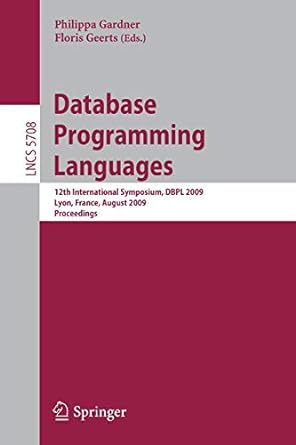Answered step by step
Verified Expert Solution
Question
1 Approved Answer
Subject: Database Topic: Employee Attendance Tracker Database Conceptual Design ( 1 0 points ) In this milestone, students will use the technical info provided in
Subject: Database
Topic: Employee Attendance Tracker
Database Conceptual Design points
In this milestone, students will use the technical info provided in milestone to build the conceptual design of the database ERD and to create a detailed description of all the entities in the database.
IMPORTANT: sections VI and VII from this milestone must be done concurrently
Section VI: Entity Relationship Diagram ERD points
Create an Entity Relationship Diagram ERD that will represent the conceptual high level design of your relational database system. This ERD must be done using a software tool that supports drawing diagrams. For this section of the milestone, you MUST use draw.io Note: handdrawing diagrams are not allowed
The diagram must contain at least STRONG entities to get credit for this checkpoint. Otherwise, the ERD will be considered incomplete; No exceptions!
Once the ERD is completed, save it as "erd.drawio" and upload it into the files folder found in this directory. In addition, your ERD must be exported pdf png jpg and must be embedded into your technical document created from milestone Screenshots of your ERD are also allowed as long as the image is readable and high quality. If we can't read your ERD, no credit will be given for this checkpoint
Section VII: Entity Description points
This section MUST be completed concurrently with section VI because most of the weak entities will be unknown until the ERD is completed. When describing your entities state clearly their form strong or weak and include at least three attributes per entity. The attributes must be defined by their domain and form. Below, you can find several examples of entities descriptions.
User Strong
userid: key, numeric
name: composite, alphanumeric
dob: multivalue, timestamp
Book Strong
ISBM: key, alphanumeric
title: composite, alphanumeric
author: composite, alphanumeric
Role Strong
roleid: key, numeric
description: alphanumeric
Account Weak
id: key, numeric
user: key, numeric
role: key, numeric
Note: give meaningful names to your entities and your attributes. For instance 'rid' is not a good attribute name for the id of the role
Step by Step Solution
There are 3 Steps involved in it
Step: 1

Get Instant Access to Expert-Tailored Solutions
See step-by-step solutions with expert insights and AI powered tools for academic success
Step: 2

Step: 3

Ace Your Homework with AI
Get the answers you need in no time with our AI-driven, step-by-step assistance
Get Started


